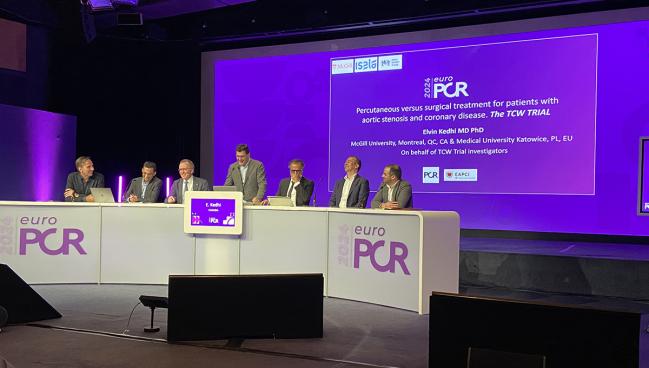NOW PUBLISHED - Latest TAVI vs Surgery Trial Raises Eyebrows in Aortic Stenosis Plus CAD
(NOW PUBLISHED) Interventionalists were stunned by the results—a clear win for PCI/TAVI—but surgeons argued the devil is in the details.

TCTMD reported in-depth on the Transcatheter Valves and Vessels (TCW) trial, May 14, 2024, at the EuroPCR 2024 meeting. The full manuscript was subsequently published in The Lancet on December 4, 2024. The published results closely match the presentation. Find our full coverage below. |
PARIS, France—Cardiologists attending the opening day of the EuroPCR 2024 meeting reacted with shock—and some skepticism—to the latest study results comparing surgical and percutaneous approaches, this time in patients with both obstructive coronary artery disease and symptomatic severe aortic stenosis.
“We had to stop the trial because we had very clear mortality differences between the study arms,” Kedhi told the media during a morning press conference.
At 1 year, the primary endpoint of all-cause mortality, MI, disabling stroke, clinically driven target vessel revascularization, valve reintervention, and life-threatening or disabling bleeding occurred in 22.9% of those treated with SAVR and CABG surgery compared with 4.4% of those who underwent TAVI and PCI (P < 0.001 for noninferiority and superiority).
All-cause mortality and stroke occurred in 12.5% of patients in the surgical arm, compared with 1.1% of those treated percutaneously (P = 0.03 for superiority).
EuroPCR Course Directors William Wijns, MD, PhD (Lambe Institute for Translational Medicine and CÚRAM, Galway, Ireland), and Jean Fajadet, MD (Clinique Pasteur, Toulouse, France), both called the results “shocking.” Matti Adam, MD (University Hospital, Cologne, Germany), a panelist during the late-breaking clinical trial session, said he was “thunderstruck.”
Kedhi, however, doesn’t believe their results are all that extraordinary.
“When we look at the results of this trial, it is not that the results of surgery are worse than what we know,” he told TCTMD. “If you look at the surgical results between our trial and SURTAVI, for example, the results are similar. The difference that we see here is that the TAVI and PCI arm does pretty good.”
He emphasized that the TCW trial is small and requires further validation but pointed out that a retrospective series of patients with severe aortic stenosis and coronary disease from Spain, presented elsewhere at the meeting, showed similar results. On the whole, Kedhi said the results suggest that a percutaneous strategy might be best for those in need of both interventions.
Several physicians, though, told TCTMD the trial—its design, patient population, and outcomes—deserves a closer interrogation.
“We always ask ourselves the question, what is better in this patient population? And now we know—TAVI plus PCI is better,” said Hendrik Treede, MD (University Hospital, Mainz, Germany). “But is it?” Like several of the panelists, Treede said the devil is in the details.
Gilbert Tang, MD (Mount Sinai Health System, New York, NY), speaking with TCTMD, said the primary endpoint, which includes life-threatening or disabling bleeding, inevitably favors the less invasive approach. Moreover, he questioned the age of patients randomized, noting that TCW included a fairly sizeable group (18.0%) of those 80 years and older.
“All of that really lays a bias against the surgical arm,” Tang told TCTMD.
Stopped at 50% Enrollment
Patients with both severe aortic stenosis and significant coronary artery disease are frequently encountered in clinical practice, prompting regular debates as to the best way to treat them. For those eligible for TAVI, research suggests that stenting obstructive vessels before the valve procedure is not necessary in advance, but this leaves open the question of what should be done if coronary disease worsens after the valve is replaced.
In the guidelines for myocardial revascularization from the European Society of Cardiology/European Association of Cardiothoracic Surgery, SAVR is indicated for patients with severe aortic stenosis undergoing CABG surgery (recommendation 1C), but no randomized trial to date has compared a combined SAVR/CABG against percutaneous treatment with TAVI/PCI.
The TCW trial included symptomatic patients 70 years and older with severe aortic stenosis and coronary artery disease, the latter of which was defined as two or more de novo lesions with a 50% of greater diameter stenosis (or single LAD lesion ≥ 20 mm length or involving a bifurcation). Based on a heart team discussion, all patients were eligible for TAVI plus PCI guided by fractional flow reserve (FFR) or a combined SAVR and CABG surgery.
Originally planned to include 328 patients, just 172 were enrolled (68.6% male), including 91 patients randomized to TAVI plus FFR-guided PCI and 81 to SAVR/CABG surgery. The mean age of patients was 76 years, and the mean EuroSCORE II and STS risk scores were 3.0% and 3.4%, respectively. The majority of patients (77.2%) were considered low risk for surgery, and mean SYNTAX score was 13.4%. Just 3.0% of patients with left main coronary artery disease were included in the study.
For the patient-oriented composite endpoint, which was tested first for noninferiority and then for superiority, the difference was driven by more deaths, including cardiovascular deaths, and more life-threatening or disabling bleeding with surgery. The MACE endpoint, which included the primary endpoint minus bleeding—occurred in 13.7% and 3.3% of those treated with SAVR/CABG and TAVI/PCI, respectively.
There was no significant difference in the risk of stroke at 30 days or 1 year, but rates of atrial fibrillation were higher with surgery.
In the Spanish retrospective study, which was presented on the second day of EuroPCR by Ignacio Amat-Santos, MD (Hospital Clínico Valladolid, Spain), investigators analyzed outcomes of 625 patients treated with PCI and TAVI and 713 treated surgically between 2018 and 2021. At 1 year, the rate of all-cause mortality and stroke was 13.0% with surgery and 9.5% with PCI/TAVI. In a matched analysis, the risk of all-cause mortality was 15.8% with CABG/SAVR compared with 9.9% for those treated percutaneously.
Ajay Kirtane, MD (NewYork-Presbyterian/Columbia University Irving Medical Center, New York, NY), said the surgical results from the randomized trial don’t reflect what he sees in clinical practice.
“There can be reasons for it,” he said. “There could some adverse events [with surgery] that led, unfortunately, to the termination of the trial, but if you look at the absolute number of events, they’re small.”
For example, at 30 days there were just 11 primary endpoint events in the SAVR/CABG arm compared with a single event in the TAVI/PCI group, a difference driven by seven life-threatening bleeds with surgery versus one with TAVI/PCI. As a result, he’s uncertain how informative the study can be to clinical practice.
“There’s no way you can be definitive about [the numbers],” Kirtane told TCTMD. “You add just three random bleeds here and this completely shifts.”
Nuances of Study Findings
To TCTMD, Tang pointed to several concerns he had with the trial. For one, he highlighted the heterogeneity of randomized patients, saying the baseline characteristics suggest there was a different burden of coronary disease between study groups. Additionally, the rates of complete revascularization differed between those in the surgery arm and those treated percutaneously (65.6% vs 81.3%, respectively), while the use of venous grafts with surgery was considerably high at 18.8%. Finally, revascularization guided by FFR differed by study arm, too (30% with surgery vs 81% with TAVI/PCI)
Although the 30-day mortality rate with SAVR/CABG “was not bad” at 1.3%, he questioned whether the higher risk of death at 1 year (9.74% with surgery vs zero deaths with PCI/TAVI) might be attributable to incomplete revascularization. Age and baseline risk could have also been factors.
“Once you're 80-plus, in the contemporary role of TAVI, do you really have equipoise to randomize someone to surgery when you can essentially do PCI and TAVI?” said Tang. He wondered what the results might have looked like had researchers excluded those 80 years and older as well as those with a high STS score.
Treede, the other cardiovascular surgeon, also emphasized age. The European guidelines, for example, recommended TAVI for patients 75 years or older, with surgery reserved for younger, low-risk patients.
“From today’s perspective, I would say we’re much on the side of TAVI in the elderly rather than doing a combined surgical procedure,” he told TCTMD. Nonetheless, “the trial showed excellent results for TAVI/PCI after 1 year of follow-up, that can’t be debated. Zero mortality is fantastic.”
For younger patients, Treede said it’s still an open question as to what combined procedure would be best in those with severe AS and obstructive coronary artery disease.
On the whole, Kedhi emphasized that their results should be corroborated and noted this present study was not easy given challenges with enrolling patients. As for why mortality was higher between 30 days and 1 year, Kedhi said it may be that patients developed complications during the surgery, lingering in the intensive care unit for a month or longer before expiring. It’s also possible these patients went home but returned to hospital for complications that developed during the surgery or in the early days afterwards.
Michael O’Riordan is the Managing Editor for TCTMD. He completed his undergraduate degrees at Queen’s University in Kingston, ON, and…
Read Full BioSources
Kedhi E, on behalf of the TCW Trial investigators. Percutaneous versus surgical treatment for patients with aortic stenosis and coronary disease: the TCW trial. Presented at: EuroPCR 2024. May 14, 2024. Paris, France.
Disclosures
- Kedi reports lecture and proctoring fees from Abbott Vascular and institutional grants from Medtronic and Abbott.






Comments